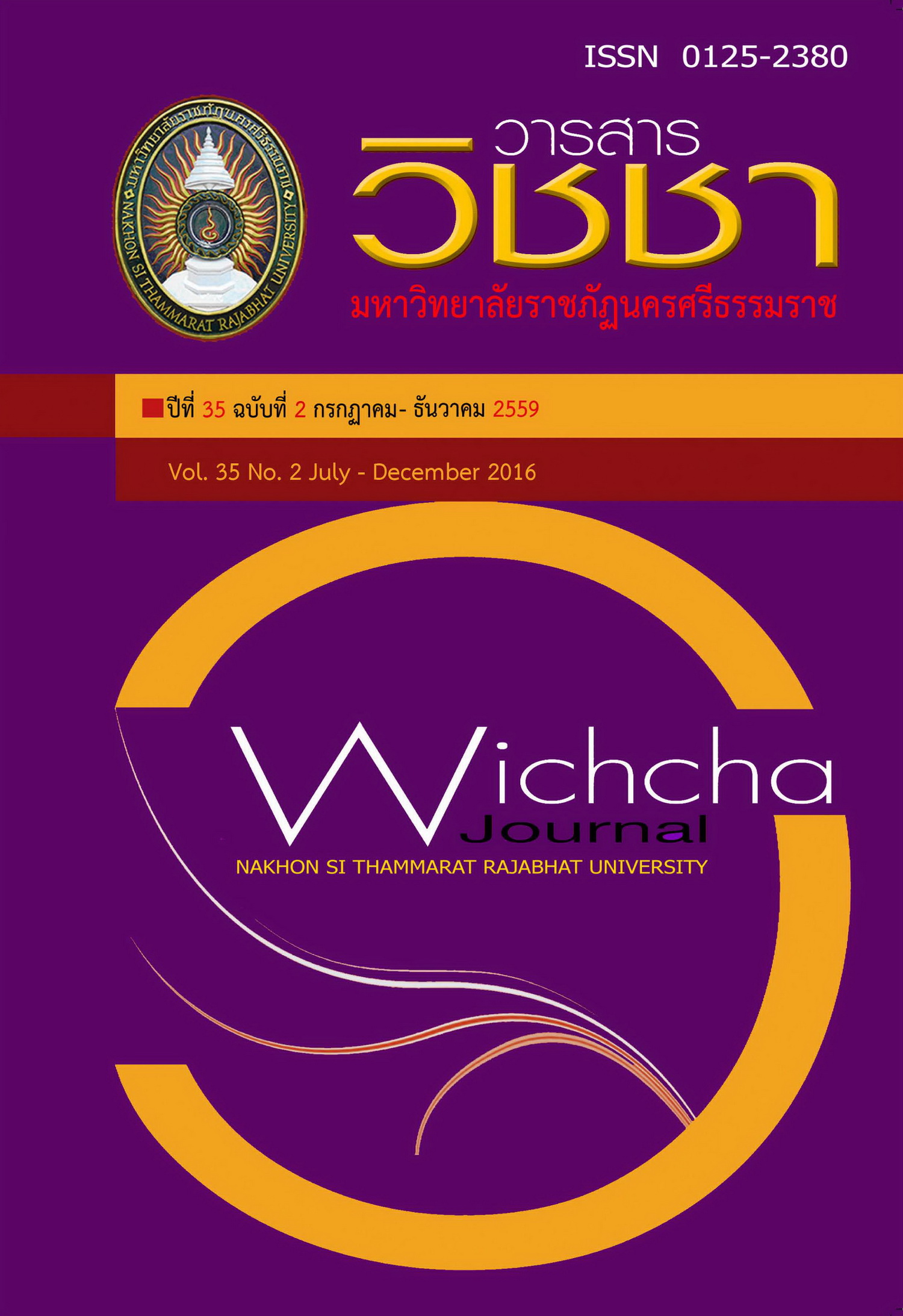การเปลี่ยนแปลงทางเคมีและจุลชีววิทยาของผลิตภัณฑ์ปอเยาะทุเรียนระหว่างการหมัก Chemical and Microbiological Changes in Durian Poyah During Fermentation
Main Article Content
Abstract
ปอเยาะทุเรียนเป็นผลิตภัณฑ์อาหารหมักพื้นเมืองชนิดหนึ่งที่ได้จากการนำเนื้อทุเรียน
สดมาปรุงรสด้วยเกลือและพริกแล้วนำไปหมักงานวิจัยนี้ได้ศึกษาการเปลี่ยนแปลงทางเคมีและจุล
ชีววิทยาของผลิตภัณฑ์ปอเยาะทุเรียนในระหว่างการหมักที่อุณหภูมิห้อง (25-30oC) เป็นเวลา 5 สัปดาห์
จากการศึกษาการเปลี่ยนแปลงทางเคมี พบว่าค่า pH ของผลิตภัณฑ์ลดลงจาก 5.1 ไปเป็น 4.37 เมื่อ
สิ้นสุดการหมัก มีผลทำให้ค่าความเป็นกรดเพิ่มขึ้นจากร้อยละ 1.66 เป็นร้อยละ 10.13 ปริมาณ
ความชื้น เถ้า และเส้นใยมีค่าเพิ่มขึ้นอย่างมีนัยสำคัญทางสถิติ (p<0.05) ในขณะที่ปริมาณ
คาร์โบไฮเดรต โปรตีน และไขมันมีค่าลดลงเมื่อระยะเวลาในการหมักเพิ่มขึ้น และเมื่อศึกษาการ
เปลี่ยนแปลงทางจุลชีววิทยาโดยติดตามการเปลี่ยนแปลงปริมาณแบคทีเรียทั้งหมด ยีสต์รา และ
แบคทีเรียแลกติก พบว่าปริมาณแบคทีเรียทั้งหมดในแต่ละสัปดาห์ตั้งแต่สัปดาห์ที่ 1 ถึง 5 จะมี
ปริมาณที่แตกต่างกันเท่ากับ 16.2 ± 0.84 x 104, 15.6 ± 1.22 x 104, 12.3 ± 0.65 x 104, 9.3 ±
1.33 x 104และ 5.3 ± 0.05 x 104 CFU/g ตามลำดับ ปริมาณยีสต์ราทั้งหมดเท่ากับ 10.8 ± 1.11 x
104, 10.3 ± 2.31 x 104, 8.6 ± 0.88 x 104, 4.3 ± 1.08 x 104และ 3.3 ± 0.02 x 104 CFU/g
ตามลำดับ ณ สัปดาห์ที่ 1, 2, 3, 4 และ 5 และปริมาณแบคทีเรียแลกติกทั้งหมดเท่ากับ 13.2 ± 0.3
x 104, 12 ± 0.57 x 104, 10 ± 0.95 x 104, 3 ± 0.4 x 104และ 2 ± 0.25 x 104 CFU/g
ตามลำดับ และจากการศึกษาเปรียบเทียบปริมาณฟีนอลิก ฟลาโวนอยด์ และฤทธิ์การกำจัดอนุมูล
อิสระ ABTS ของทุเรียนสดและผลิตภัณฑ์ปอเยาะทุเรียน พบว่าทุเรียนสดมีปริมาณฟีนอลิกทั้งหมด
น้อยกว่าผลิตภัณฑ์ปอเยาะทุเรียน โดยมีค่าเท่ากับ 0.04 ± 0.04 μgGAE/gdwและ 0.18 ± 0.14
μgGAE/gdwตามลำดับ ในขณะที่ปริมาณฟลาโวนอยด์ในทุเรียนสดและผลิตภัณฑ์ปอเยาะทุเรียนไม่มี
ความแตกต่างกัน และทุเรียนสดแสดงฤทธิ์การกำจัดอนุมูลอิสระABTS สูงกว่าผลิตภัณฑ์ปอเยาะ
ทุเรียน
Durian poyah, one of the traditional fermented products, can be produced
by mixing durian flesh with salts and chili prior to fermentation. This research aimed
to investigate the chemical and microbiological changes in durian poyah products
during fermentation at ambient temperature (25-30oC) for 5 weeks. At the end of
fermentation, the pH of durian poyah reduced from 5.1 to 4.37, along with the
increase in total acidity from 1.66 to 10.13%. Moisture, ash and fiber contents
increased while carbohydrate, protein and fat contents decreased with increasing
fermentation time. For the microbiological property, total bacteria count, total yeast
and mold and total lactic acid bacteria were monitored. It was found that all
microbiological counts varied considerably during fermentation. Total bacteria
counts from 1st to 5th weeks were 16.2 ± 0.84 x 104, 15.6 ± 1.22 x 104, 12.3 ± 0.65 x
104, 9.3 ± 1.33 x 104 and5.3 ± 0.05 x 104 CFU/g, respectively. Total yeast and mold
were 10.8 ± 1.11 x 104, 10.3 ± 2.31 x 104, 8.6 ± 0.88 x 104, 4.3 ± 1.08 x 104 and 3.3 ±
0.02 x 104 CFU/g at weeks 1, 2, 3, 4 and 5, respectively and total lactic acid bacteria
were 13.2 ± 0.3 x 104, 12 ± 0.57 x 104, 10 ± 0.95 x 104, 3 ± 0.4 x 104 and 2 ± 0.25 x
104 CFU/g, respectively. The comparative study on phenolic content, flavonoid
content and ABTS free radical scavenging activity of fresh durian and durian poyah
revealed that fresh durian had lower phenolic content than those durian poyah
(0.04 ± 0.04 vs 0.18 ± 0.14 μgGAE/gdw). No difference in total flavonoid content was
noticeable between both samples. However, fresh durian showed superior ABTS free
radial scavenging ability to poyah durian.
Article Details
เนื้อหาและข้อมูลในบทความที่ลงตีพิมพ์ในวารสารวิชชา มหาวิทยาลัยราชภัฏนครศรีธรรมราช ถือเป็นข้อคิดเห็นและความรับผิดชอบของผู้เขียนบทความโดยตรง ซึ่งกองบรรณาธิการวารสารไม่จำเป็นต้องเห็นด้วยหรือร่วมรับผิดชอบใด ๆ
บทความ ข้อมูล เนื้อหา รูปภาพ ฯลฯ ที่ได้รับการตีพิมพ์ในวารสารวิชชา มหาวิทยาลัยราชภัฏนครศรีธรรมราช ถือเป็นลิขสิทธ์ของวารสารวิชชา มหาวิทยาลัยราชภัฏนครศรีธรรมราช หากบุคคลหรือหน่วยงานใดต้องการนำข้อมูลทั้งหมดหรือส่วนหนึ่งส่วนใดไปเผยแพร่ต่อหรือเพื่อการกระทำการใด ๆ จะต้องได้รับอนุญาตเป็นลายลักษณ์อักษรจากวารสารวิชชา มหาวิทยาลัยราชภัฏนครศรีธรรมราชก่อนเท่านั้น
The content and information in the article published in Wichcha journal Nakhon Si Thammarat Rajabhat University, It is the opinion and responsibility of the author of the article. The editorial journals do not need to agree. Or share any responsibility.


